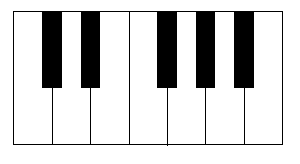Thoughts on Piano Keyboard Design
This is taken from Piano Keys on www.mathpages.com.

If you've ever looked closely at a piano keyboard you may have noticed that the widths of the white keys are not all the same at the back ends (where they pass between the black keys). Of course, if you think about it for a minute, it's clear they couldn't possibly all be the same width, assuming the black keys are all identical (with non-zero width) and the white keys all have equal widths at the front ends, because the only simultaneoussolution of 3W=3w+2b and 4W=4w+3b is with b=0. After realizing this I started noticing different pianos and how they accommodate this little problem in linear programming. Let W denote the widths of the white keys at the front, and let B denote the widths of the black keys. Then let a, b,..., g (assigned to their musical equivalents) denote the widths of the white keys at the back. Assuming a perfect fit, it's impossible to have a = b = ... = g. The best you can do is try to minimize the greatest difference between any two of these keys. One crude approach would be to set d=g=a=(W-B) and b=c=e=f=(W-B/2), which gives a maximum difference of B/2 between the widths of any two white keys (at the back ends). This isn't a very good solution, and I've never seen an actual keyboard based on this pattern (although some cartoon pianos seems to have this pattern). A better solution is to set a=b=c=e=f=g=(W-3B/4) and d=(W-B/2). With this arrangement, all but one of the white keys have the same width at the back end, and the discrepancy of the "odd" key (the key of "d") is only B/4. Some actual keyboards (e.g., the Roland HP-70) use this pattern. Another solution is to set c=d=e=f=b=(W-2B/3) and g=a=(W-5B/6), which results in a maximum discrepancy of just B/6. There are several other combinations that give this same maximum discrepancy, and actual keyboards based on this pattern are not uncommon. If we set c=e=(W-5B/8) and a=b=d=f=g=(W-3B/4) we have a maximum discrepancy of only B/8, and quite a few actual pianos use this pattern as well. However, the absolute optimum arrangement is to set c=d=e=(W-2B/3) and f=g=a=b=(W-3B/4), which gives a maximum discrepancy of just B/12. This pattern is used on many keyboards, e.g. the Roland PC-100. The "B/12 solution" is best possible, given that all the black keys are identical and all the white keys have equal widths at the front ends. For practical manufacturing purposes this is probably the best approach. However, suppose we relax those conditions and allow variations in the widths of the black keys and in the widths of the white keys at the front ends. All we require is that the black keys (in total) are allocated 5/12 of the octave. On this basis, what is the optimum arrangement, minimizing the maximum discrepancy between any two widths of the same type? Let A, B,...G denote the front-end widths of the white keys, and let a#, c#, d#, f#, g# denote the widths of the black keys. I believe the optimum arrangement is given by dividing the octave into 878472 units, and then setting
f=g=a=b=72156 units
c=d=e=74606 units
discrepancy=2450
f#=g#=a#=72520 units
c#=d#=74235 units
discrepancy=1715
F=G=A=B=126546 units
C=D=E=124096 units
discrepancy=2450
The maximum discrepancy between any two widths of the same class is 1/29.88 of the width of the average black key, which is less than half the discrepancy for the "B/12 solution". The max discrepancy is 1/358.56 of the total octave for the white keys, and 1/512.22 for the black keys. Since an octave is normally about 6.5 inches, the max discrepancy is about 0.0181 inches for the white keys and 0.0127 inches for the black keys. (One peculiar fact about this optimum arrangement is that the median point of the octave, the boundary between f and f#, is exactly 444444 units up from the start of the octave.)
References:
|  :: next lesson
:: next lesson